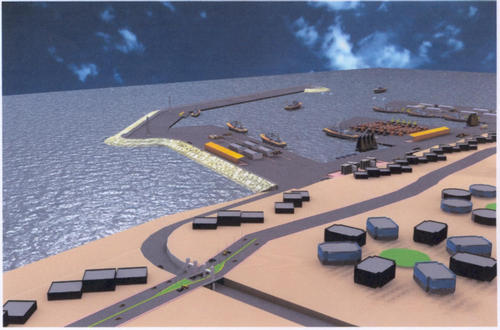What's New Page
Management Information System for Gaza Seaport
Port operations comprise a wide range of complex and interfacing activities. The use of computers is essential to provide the integrity activities. The use of computers is essential to provide the integrity and integration of the information evolved in the system.
As in any other type of business, the use of computers in ports is increasing. Expanding customer demand, fast development of teletransmission of data in shipping, and growing competition among ports force ports to implement computerized information systems to improve the level of services.
Decision making requires information that is relevant for the decision and is received in a timely fashion. Decisions can usually be divided into (1) medium-to long-term or planning decisions affecting investment, resource acquisition or disbursement, costs and prices, operating policy and marketing, and (2) short-term or operational decisions that affect the allocation and use of resources required to perform the operation and services demanded of the port.
Management information systems (MIS) arc therefore basic formal structures for information gathering, manipulation, storage, retrieval, and submittal to decision makers.
Introduction
This research is mainly concerned with designing and implementing an information system using a Database Management System (DBMS).
Our objective was to choose a real case study where all phases involved in generating the Information System could be implemented, while benefits gained by applying it could be easily sensed and measured.
The case study I have chosen is Gaza seaport since it is only port in Palestine. It is considered an important gate to both cargo and passengers. In fact a lot of Palestine's imports enter through this port which led to its increased economical importance
This led us to take a closer look at how the work progresses at this port and unfortunately I have found that the manual system applied now is extremely inefficient. It is considered to be a very primitive system considering the importance of Gaza seaport, and substantial improvements that could be achieved if a computer system is used instead.
Therefore our proposed project is a database management system using database engine which stores, retrieves and processes data reliably in order to overcome the numerous disadvantages of the manual system which I will carefully discuss later on. In addition I will state the improvements our system offers to the port management system.
The main phases that I went through to complete the project will be outlined, followed by a detailed description of the analysis, design and development phases. Then I will describe the different options I added to facilitate interactions with the database. Some of these include the error messages, which appear accompanied by guidance on why this error has occurred and how it could be corrected.
Finally samples of the screens and reports generated by the system wilt be presented to demonstrate the performance of the system.
1.2 Objectives of the research:
The- main objective of this project is to choose a real case study suitable for applying database concepts, which means that I want to design and implement an information system using a Database Management System (DBMS). Furthermore I want to apply formal and new techniques in the different phases involved in generating an Information System.
The techniques applied in each phase are as follows:
1. Requirement formulation and analysis phase. This phase included fieldwork to examine real documents and conduct interviews.
2. The analysis depended on the use of function hierarchy diagram and Data Flow Diagrams (DFD) which will be explained in the next chapter
3. System design phase. In which a conceptual data model, Entity Relation Diagram is used to represent the entities and attributes of the system. In addition, I have used techniques such as schema and subschema to represent our design.
4. Implementation phase. At which I used to implement the final design sought.
5. System testing phase. Where special test data sets are used to ensure that the system meets its specifications.
6. Documentation phase. In which all the work done in the previous phases is documented and all diagrams and models are includes.
7. The previously mentioned phases will be described in details later in this chapter.
